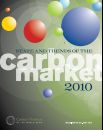Global Carbon Market Grows to $144 billion Despite Financial and Economic Turmoil
-----------------
Cologne, May 26, 2010—The latest annual report from the World Bank on the global carbon market showed that in 2009 it grew to $144 billion, up 6% from 2008 despite enduring its most challenging year to date. The global economic crisis negatively impacted both demand and supply sides and, as industrial output plummeted, the demand for carbon assets fell. The State and Trends of the Carbon Market 2010, released today by the World Bank at Carbon Expo in Cologne, also said that on the supply side, the reduction in access to capital made it difficult for many project developers to lock in financing. As a consequence, project origination ground to a halt.
The State and Trends report analyzes data from the trading of European Union Allowances (EUAs) and secondary Kyoto offsets under the European Union Emissions Trading Scheme (EU ETS). It also evaluates transactions under the Kyoto markets: Certified Emission Reductions (CERs), Emission Reduction Units (ERUs), and Assigned Amount Units (AAUs), as well as data from voluntary markets.
“The annual State and Trends report has become a flagship publication for the World Bank and, indeed, continues to provide the world with objective and well-informed assessments of the carbon market. The authors have again succeeded in accurately measuring the pulse of the market in an extremely difficult year”, says Warren Evans, Director of the World Bank’s Environment Department.
The EU ETS remained the engine of the global carbon market with over 6 billion EUAs transacted in 2009 for a total value of US$118 billion. On the other hand, project-based transactions declined by 54% to US$3.4 billion in 2009, led by CDM, which declined by 59% to an estimated US$2.7 billion with slightly more than 200 million tons of CO2e transacted at an average price of US$12.7. As the forescast for offsets (CERs and ERUs) available for compliance looked increasingly somber, countries with compliance needs under the Kyoto Protocol turned to AAUs, seeking sizable and predictable assets. The AAU market increased, reaching US$2 billion in 2009, a dramatic 7-fold increase compared with 2008.
With the weakening demand for pre-2013 offsets and the lack of traction on the post-2012 front, the residual demand for Kyoto assets could reach 230 million tons by 2012. A large share of the demand for offsets under the EU Climate and Energy Package remains to be contracted, thus theoretically sustaining future demand and prices.
“Ironically, the same issues that have hindered the project-based mechanisms may ultimately be the silver lining that sets the stage for a stronger post-2012 market. Nonetheless, clear policy and regulatory signals must be provided urgently if a stronger global market is to emerge”, said Alexandre Kossoy, co-author of the report.
Another trend in 2009 was the development of national mitigation efforts. One of the best pieces of news came from New Zealand which established the first economy-wide and mandatory ETS outside Europe. In addition, new initiatives in developing and developed countries are emerging, exploring market approaches for climate finance solutions. In that context, carbon finance remains as an important tool to provide incentives to a shift to a lower carbon development path.
“Considerable effort, ingenuity, and capacity will be required for carbon finance mechanisms, along with other policy and finance instruments, to address the urgency and the scale of the climate challenge”, said report co-author Philippe Ambrosi.
The report was released at CARBON EXPO 2010, the largest carbon fair in the world with more than 3,000 representatives from governments, private sector and civil society organizations involved in greenhouse gas emission reduction transactions around the world.
|
Global Carbon Market Grows to $144 billion |
---------------


